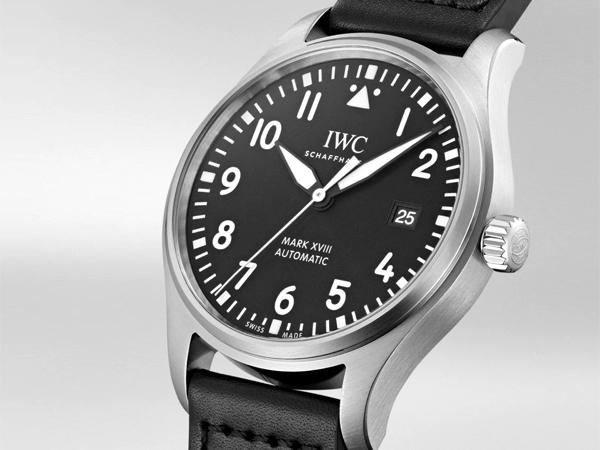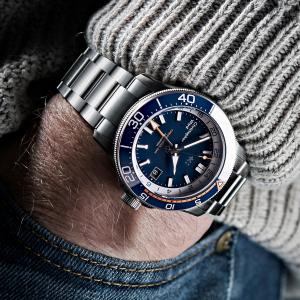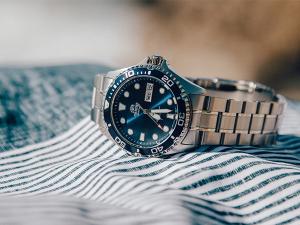IWC Mark XVIII: The Quintessential Pilot’s Watch

Known for its quality aviation watches, IWC launched a sought-after successor to the IWC Mark XVII in 2016. Modestly priced as compared to other timepieces from the IWC Pilot’s Watch collection, this watch certainly provokes with its unique features. In line with the iconic Mark 11 watch, the IWC Mark XVIII comes with much improvement. However, it also bears great similarities with the IWC Mark XVI.
What upgrades can you expect from the new IWC Mark XVIII watch? Is it really the best among the line of celebrated aviation watches? In this article, we’ll take a closer look at the Pilot’s Watch Mark XVIII and see how it evolved through the years.
History of IWC Schaffhausen
How IWC established itself as one of the leading watchmakers in the world didn’t come without struggles. The turbulent ride, however, resulted in the brand’s prestige today. Founded by American engineer and watchmaker Florentine Ariosto Jones, IWC met with great hurdles through its humble beginnings.
F.A. Jones lived in Boston and at age 27 served as Deputy Director and Manager of the E. Howard Watch and Clock Co. The brand revolutionised the American watchmaking industry in more ways than one. What’s more, the economy of the country helped boost the many different companies emerging left and right. At the time, a lot of people travelled to the United States, hoping to try their luck and start anew. But F.A. Jones thought differently. In fact, he did exactly the opposite. From the US, he travelled to Europe, aspiring to start his own company. But it wasn’t a smooth-sailing ride, so to speak. He found himself against a thriving industry that had great demands. F.A. Jones’ luck didn’t pull off quite as well as he intended it to.
Expansion of IWC in Schaffhausen
F.A. Jones had great hopes for the company, and this was reflected in the company’s name — the International Watch Company. He wanted to explore the greatness of Europe and leverage all he can into providing people with high-quality timepieces. Firstly, he sought to employ the help of Swiss locals as watchmakers. Jones believed in their expertise and saw that, combined with modern technology, the company will thrive in the market.
With the low wages that challenged Switzerland, a lot of people saw this as an opportunity. However, sceptics remained to question each and every move Jones made. In the town of Schaffhausen, he found the perfect place to put up his first factory. With the help of watch manufacturer and industrialist Heinrich Moser, IWC opened the town’s first-ever hydroelectric plant. For a while, the International Watch Company stood as the only watch manufacturer in north-eastern Switzerland.
As Jones saw strengths in expanding the business, investors got more and more agitated. By 1875, the IWC plant by the River Rhine allowed 300 workplaces with 196 workers. The 45-metre long factor completely relied on hydroelectricity in producing high-quality pocket watch movements. But with the pressure coming from investors, F.A. Jones ultimately had to quit and return to his home in the United States.
F.A. Jones’ Departure and IWC’s New Management
Years after dedicating every waking moment to producing watches, Jones left Schaffhausen. As he went home, a family of Schaffhausen industrialists bought the company — the Rauschenbachs. IWC saw four generations of Rauschenbachs lead the company. Under them, IWC produced pocket watches that featured a ‘Pallweber’ display, as well as wristwatches for both men and women.
Following the death of Johannes Rauschenbach-Schenk, Ernst Jakob Homberger took over management in the company. Under Homberger’s management, IWC saw the birth of the ‘Spezialuhr für Flieger’, which began the production of pilot watches in Schaffhausen.

The Evolution of IWC Mark Pilot’s Watches
The launch of the IWC Pilot’s Watch coincided with the prime age of aviation watches. It started with the Cartier Santos watch, followed by the launch of Longines’ Hour Angle watch. Then, in the late 1930s, the IWC Special Pilot’s Watch was launched. It featured the company’s Calibre 83 movement with an antimagnetic escapement. It also includes a shatterproof crystal. The hands and indexes contrasted greatly with each other, as well as with the rotating bezel that helped measure short periods of time. In particular, the arrowhead index proved efficient in registering take-off times. Due to its material, it also became highly resistant to fluctuations in temperatures between -40 and +40 degrees Celsius.
Soon after, with the great success of the Pilot’s Watch, the Big Pilot’s Watch Ref. IW431 was introduced. Measuring 55mm in case diameter and 16.5mm in height, it truly was a hefty timepiece. It also became IWC’s biggest watch to be ever manufactured, equipping the German Air Force in 1940 with 1,000 limited-edition timepieces. Then, about eight years later, the Mark 11 was launched — one of the most iconic timepieces that, to this day, collectors continue to vie for.
IWC Mark 11
The IWC Mark 11 Pilot’s Watch is, to say the least, one of IWC’s most priced timepieces. This antimagnetic watch came with a NATO strap and the Calibre 89 movement. As a response to the British government’s request for the company to supply timepieces to the Royal Air Force or RAF, the Mark 11 took flight.
A lot of people would include the IWC Mark X on the list of Mark watches to denote. However, the Mark X, given that it isn’t anti-magnetic, isn’t a Pilot’s Watch. Instead of the RAF, the Mark X was made for the British Army. It’s also only sized at 35mm compared to 36mm of the Pilot’s Watch. Despite this, it became popular due to its legibility.

IWC Mark XII and IWC Mark XV
For almost four decades, the Mark 11 reigned as one of the most popular aviation watches of its time. It also went on without replacement for years. However, with the incessant demand from collectors, IWC launched the Mark XII — a 36mm watch that appears to be a placeholder. Soon after the IWC Mark XV was introduced, a bigger version of the XII at 38mm with an automatic movement was launched. It also has a white dial version that wasn’t present in any of its predecessors.
IWC Mark XVI and IWC Mark XVII
As IWC went on to put out more Mark watches, the size of the timepieces grew with each generation. The Mark XVI, perhaps the most relevant timepiece from the Mark XVIII, was launched in 2006 with a 39mm case. The ‘Flieger’ hands on the dial also appear broader. The numbers 6 and 9 were also dropped from the dial, and the watch comes with either a steel bracelet or a leather strap. The XVI inspired many other versions like the IWC Mark XVI Spitfire, Father & Son, and Japan that was limited only to 350 pieces.
In 2012, IWC seemed to experiment on the look of the watch with the Mark XVII. With a 41mm case, it’s the biggest Mark watch yet. This timepiece features a distinct vertical date display with a red arrow pointing to today’s date. The watch also has the newly developed steel bracelet that includes a fine adjustment clasp. For four years, IWC went on to produce the Mark XVII.
Then, in 2016, a modern classic was born — the IWC Mark XVIII.
The IWC Mark XVIII
IWC Mark XVIII saw a reversal on certain updates made with the Mark XVII. Among those include the dial design as well as the size. Compared to its predecessors, let’s take a closer look at this watch. What makes it so good and what are we looking forward to its future versions?

1. Case & Dial
The overall design of the IWC Mark XVIII makes it a very versatile piece. We stand with our words by calling it a modern classic. It’s simple and it doesn’t stand out much. But when it comes down to it, you’ll surely find a way to tell great tales about this watch given its hierarchy. It’s a completely understated watch that doesn’t take away from its wearer. It’s also comfortable and particularly easy to wear despite its size. The brushed detail also gives it a solid look.
The Mark XVIII easily gives off a classy vibe when worn. It’s an effortless choice of timepiece that anyone can put on. At 40mm, it’s a tad smaller than the Mark XVII. The big difference between the two lies in the dial design. The Mark XVIII brought back the date window, a step back from the experimental date dial on the Mark XVII.
The lume on this timepiece also proves to be decent. It’s not overbearing or even underwhelming. It provides just the perfect lume for dimly lit places. Even after the Super Luminova wears off, it still remains a trusty timepiece. There can be improvements made on the lume of this watch, but it sure is efficient enough to last for years.
2. The Strap
The watch’s comfort also lies in the fact that it has a nice grip on its leather strap. The calfskin leather feels as high quality as it is, a Santoni strap that features an orange lining. This subtle touch is a bit devoid of the watch’s overall appeal. However, it’s not a ‘love-it-or-hate-it’ type of strap. It’s something you’d either love or basically just choose to accept. But this flash of colour is not something you can just go on without noticing. It’s still orange after all. It gives a bold personality to a rather muted timepiece.
Given that it’s a leather strap, you may expect a stiff texture at first. But as worn regularly, it gets more flexible and comfortable. Next thing you know, it’s just like a part of you. This kind of strap with this kind of design makes it a good choice for a dress watch more than a sports watch. Perhaps, this is one of the reasons why it’s such a popular timepiece. It’s a casual sport watch that you can take from a workday then straight to a weekend getaway.

3. The Movement
The watch’s 35111 Calibre takes from the Sellita SW300-1 movement. It is, however, not a manufacture movement. Perhaps this is the reason behind its competitive price. But its quality and accuracy exceeded expectations. This ETA base movement beats a standard 4 Hz with 42 hours of power reserve. As usual, it’s protected from magnetic fields by the soft-iron inner case. Hidden behind a solid caseback, one can see the Junkers Ju 52 aeroplane engraved on it. The same movement powers the IWC Portofino, IWC Ingenieur, as well as IWC Da Vinci.
4. The Price
The IWC Mark XVIII is way more affordable than its immediate predecessor. And by that, we mean it’s a thousand bucks inexpensive than the Mark XVII. With price ranging between $3,000 and $4,000, it’s one of the most reasonably-priced automatic watches yet. But, again, its competition is strong. With the Breitling Navitimer or the Zenith Pilot Type 20, it’s hard to gauge whether or not you’ll get more for the price of the Mark XVIII.
There are various other versions of the Mark XVIII that came out, inspired by the success of its release. Firstly, the IWC Mark XVIII Miramar with a 41mm ceramic case and a Top Gun engraving on the back. And just like the Mark XVII, the Mark XVIII also came out with a Le Petit Prince and Antoine de Saint Exupery versions in blue and brown, respectively. IWC also released a limited-edition Mark XVIII ‘Tribute to Mark 11’. The IWC Mark XVIII Heritage has a titanium case with a more vintage look and feels to it, matched with a brown Santoni calf leather strap. Lastly, the Mark XVIII Laureus was launched in 2018 with a black ceramic case and titanium caseback, limited only to 1,500 pieces.
The Quintessential Pilot’s Watch
The great thing about watches like this is that they don’t require any special occasion to be worn. The IWC Mark XVIII can easily be anybody’s everyday timepiece. Perhaps, it’s not just a Pilot’s Watch but also a dress watch. The lack of complications only makes it easier for anyone to admire this model.
The IWC Pilot’s Watch line surely has great offers among its line-up. It’s impossible to ignore the prowess of the Spitfire or the Top Gun. Every offering from IWC truly encapsulates its rich history and legacy. The Mark XVIII isn’t just another iteration of the IWC Mark Pilot’s Watches. It’s a tribute to the collection itself. IWC looked back on the great things that the Mark series has to offer and put it on the Mark XVIII.
Loving IWC watches? Check out our picks for the best IWC Aquatimer and IWC Pilot watches!


